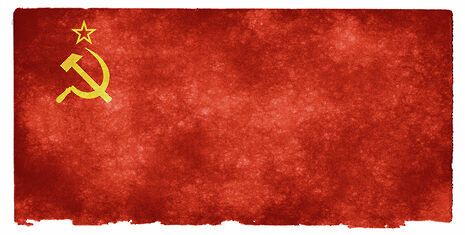Removing King’s communist flag, re-awakening radicalism
Leonardo Impett saw the King’s hammer and sickle flag as a prime example of institutionalised rebellion. He hopes that its removal will lead to students rediscovering the sentiment behind it

"The fact that a clear majority decided to keep the Hammer & Sickle flag up as it is does not by any measure mean this debate is resolved." These were the wise words of Juan de Francisco, King’s College Student Union president in 2010. Now, they’ve finally done it. After numerous attempts and extended debate, KCSU have decided to take down the infamous flag, so often a place of pilgrimage for visiting leftists speaking at the nearby Keynes Hall.
Some will be jumping for joy at the symbolic end of the college’s association with champagne socialism. The intricate, expensive-looking frame, and the university’s long self-identification with power and élites, juxtapose the revolutionary symbol to highlight its hypocrisy like some sorry experiment in Soviet montage theory. Others bemoan the end of ideology; even a Telegraph blog proclaimed student radicalism dead, complaining rather patronisingly that “the desire to uproot society is a natural part of being young.”
I’m sure you know by now the creation myth of the flag. King's students used to graffiti rude things on the (previously) red walls of the bar, including the hammer and sickle. So, the fable goes, in 2004 the fellows of King’s put up a flag they bought on eBay, to discourage that sort of thing.
To my mind, this amusing anecdote shows something much more sinister at work. In fact, it serves as a caricature example of contemporary cultural capitalism at work. What the fellows did, in our Marxist parable, was to deliberately discourage rebellion by institutionalising a tolerable amount of it. A token hammer and sickle already shines opposite the bar; no need to draw any more of them with a Sharpie on a toilet wall.
This wasn’t just about the pacification or appeasement of the college rebel; it wasn’t a lowering of the Kitchen Fixed Charge (a sort of collegiate Repeal of the Corn Laws). Rather, this was an incorporation of your anticapitalist RDA into the college establishment.
The popular Slovenian Marxist Slavoj Žižek gives us a good analogy: in the old days, by which he means pre-1968, the guilt of the consumerist act had to be compensated by an act of anti-consumerism. A great industrialist might have exploited factory-workers all day, then donated millions to a charitable institution to feed, clothe or teach their children. A usurer or a thief might have bought an indulgence from the Church, compensating for their sins. In our times, however, this act of anti-consumerism is already included in the price of the product. The act of buying a (slightly more expensive) fairtrade coffee is not only the consumerist act, it also already includes the retribution for this consumerism, in the few pence that go towards fair wages, working conditions and so on.
The super-public exhibition by the institutions of the college of a framed, sanitised hammer and sickle stopped the students’ revolutionary graffiti on the walls. Whether or not this was what the fellows had in mind, the flag has - in just a decade - completely fulfilled its purpose. Not only are the students now not actively painting their own iconography on the walls anymore, a lot of them aren’t even particularly bothered about keeping it. It has completed its mission so perfectly that it has rendered itself redundant.
Communist symbols are everywhere: the hammer and sickle in the Aeroflot logo, on the walls of countless euro-Hipster bars and nightclubs, even the red star of Prêt à Manger; none of these are more than semiotic fetishisms. And yet, Communist symbols and language, like those of Christianity, still have the power to shock, offend and scare.
So I have some hope that with the death of the flag will come the rebirth of the symbol. KCSU hope that they can continue to be politically radical in a less offensive, more tolerant manner; by putting up a rainbow flag, or an organic purple hammer and sickle. I’d prefer a portrait of Thatcher or Nixon, so students can deface it in the right and proper way.
In John’s, there are no institutionalised hammers and sickles. Students are made to bless the Queen every time they eat at formal. And last exam term, a large hammer and sickle (not Soviet, but of the Italian Communist Party) was hung over the large library window, brightly visible from Chapel Court. The porters took it down.
Leonardo Impett is Secretary of the Cambridge University Communist Society
 News / SU reluctantly registers controversial women’s soc18 December 2025
News / SU reluctantly registers controversial women’s soc18 December 2025 Features / Should I stay or should I go? Cambridge students and alumni reflect on how their memories stay with them15 December 2025
Features / Should I stay or should I go? Cambridge students and alumni reflect on how their memories stay with them15 December 2025 News / Dons warn PM about Vet School closure16 December 2025
News / Dons warn PM about Vet School closure16 December 2025 News / Cambridge study finds students learn better with notes than AI13 December 2025
News / Cambridge study finds students learn better with notes than AI13 December 2025 News / Uni registers controversial new women’s society28 November 2025
News / Uni registers controversial new women’s society28 November 2025








